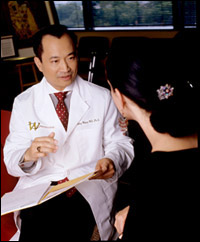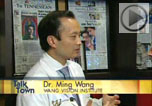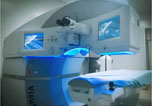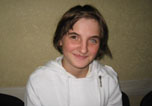- Over 55,000 LASIK and cataract procedures (including on over 4,000 doctors)
- The FIRST center in TN to offer Laser Cataract Surgery
- Introduced bladeless all-laser LASIK to the state
- Implanted the state's first FOREVER YOUNG™ Lens
- The first surgeons in the US to perform a new Intacs surgery to treat keratoconus
- Helped patients from 40 states and 55 countries
- International referral center for cataract surgery and LASIK complications
- Read Dr. Wang's book: LASIK Vision Correction
Why did you decide to have LASIK? Why did you choose Dr. Wang? How has your life changed since your LASIK procedure?
What is your advice for people considering LASIK?
Click to read more
| Home | Print This Page |
Accredited Optometric Residency
Wang Vision 3D Cataract and LASIK Center, Nashville, Tennessee

Program Title: Residency in Refractive and Ocular Surgery
Program site/affiliation: Wang Vision 3D Cataract and LASIK Center
1801 West End Avenue, Suite 1150 , Nashville , TN 37203
Director of Residency Education: Steven Hitzeman, OD
Director of Residencies, Indiana University School of Optometry
800 East Atwater Avenue
Bloomington , IN 47405
812/855-4479 P
812/855-8664 F
e-mail: hitzeman@indiana.edu
Program Supervisor: Helen Boerman, OD, FAAO
Clinical Operations Manager, WVI
615/321-8881 P
615/321-8874 F
email: DrBoerman@wangvisioninstitute.com
Mission Statement: The mission of the Wang Vision 3D Cataract and LASIK Center Residency program is to provide advanced competency in eye care in the areas of co-management of refractive surgery, ocular disease, and primary care, though education, patient care and scholarship.
Program Goals
I. To attract a diversified and well-qualified applicant pool, and to select the best-qualified candidate from that pool.
II. To provide a diverse clinical patient base to assure advanced clinical competency in evaluating patients for refractive surgery as well as in surgical techniques used in elective refractive surgery and emergency eye care related to post-operative management.
III. To provide a diverse clinical patient base to assure advanced clinical competency in Primary Care Optometry, as well as the proper diagnosis and management of ocular and ocular systemic disease
IV. To provide facilities and equipment appropriate to meet the needs of the program.
V. To provide faculty and administrative support appropriate with the needs of the residency program.
VI To provide didactic instruction to enhance advanced clinical competency.
VII. To increase the residents knowledge and skills in the area of scholarly activity.
VIII. To prepare the graduates of the residency to provide advanced eye care services with an emphasis in the area of refractive surgery and teach in the area of refractive surgery and ocular disease.
IX. To evaluate and enhance the residency program on an on-going basis and to conduct a program of such quality as to merit continued accreditation by the Accreditation Council on Optometric Education (ACOE).
Curriculum Description
This is a full time 52 week residency program, beginning July 1 and ending June 30 of each residency year.
The first week of the program is devoted to residency orientation. Plan for Orientation is attached in the Appendix.
The resident's involvement in patient care is sufficient to enable the mission, goals and objective of the program to be fulfilled. The program curriculum includes direct patient care at the WVI, assistance in training of technical staff in certain aspects of the optometric care with respect to refractive surgery, and less frequently, lectures and seminars.
The resident spends a minimum of 40 hrs at WVI each week but is additionally involved in "on call" after hours care.
The program involves very little precepting, as we do not have optometry students, but does involve delegation of testing to technicians and teaching of technician students enrolled in the Volunteer State College Technician Program.
The curriculum is designed to obtain advanced competency in areas such as:
- Topography: obtain readings on all machines on all patients, understand the indication for topography, and be able to correctly interpret findings
- Aberrometry: obtain readings on all machines on all patients, understand the indication for aberrometry, and be able to correctly interpret findings
- Pachymetry: obtain readings on all machines on all patients, understand the indication for pachymetry, and be able to correctly interpret findings
- Visual Field: obtain readings on all machines on all patients, understand the indication for visual fields, and be able to correctly interpret findings
- Refractometry: obtain readings on all machines on all patients, understand the indication for refractive analysis, and be able to correctly interpret findings
- Ocular Health Examination: Correctly identifies ocular findings using slit lamp, binocular indirect, gonioscopy, etc.
- Refractive surgery indications (choosing which surgery is best for a particular patient)
Example of Typical Week
Monday: Full clinic with all attendings. Typical patients include those seeking refractive surgery, suffering from ocular complications (acute and chronic) of refractive surgery, and ocular disease. Initial comprehensive examination includes topography, pachymetry, and refraction on all exams, as well as follow-up visits. Typical load: 30-40 patients/day.
Tuesday: Full clinic with optometry attendings primarily. Typical patients include those seeking consultations for refractive surgery, post-operative or follow-ups on patients diagnosed with ocular disease, and routine eye care. Typical load: 30-40 patients/day.
Wednesday: Full clinic with all attendings. Typical patients include those seeking refractive surgery, suffering from ocular complications (acute and chronic) of refractive surgery, and ocular disease. Initial comprehensive examination including topography, pachymetry, and aberrometry on all exams, as well as follow-up visits. Typical load: 30-40 patients/day.
Thursday: Full clinic with optometry attending. Typical patients include refractive surgery evaluations, post-operative/follow-ups on patients diagnosed with ocular disease, and primary care. Typical load: 30-40 patients/day.
Friday: Half-day clinic with Dr Wang. Typical patients include those seeking refractive surgery, patients with ocular disease and routine care. Initial comprehensive examination including topography, pachymetry, and aberrometry. The afternoon is a ½ clinic where the resident sees patients independently with no technical help. Dr. Swartz is available for consultation during this time for the first 6 months of the program. Scheduling is light, typically less than 5 patients.
Saturday: Half day twice per month or as practice requires.
Length of Program: 12 Months
Starting Date: July 1 of the program year
Salary/Stipend: $34,000/year
Benefits: Equivalent to that of Wang Vision 3D Cataract and LASIK Center employees, including medical insurance, professional liability insurance for all internal and external activities associated with WVI, and travel to one meeting where you present your work.
Completion Acknowledgement: Certificate
Therapeutics: Yes
Date Program Established: July 1, 2003
Accreditation: Yes, obtained in 2006
Prerequisites: Doctor of Optometry degree from an accredited school or college of optometry, competitive GPA and successful completion of NBEO examinations is required. Accepted candidate must obtain a TN license to practice optometry.
Number of Positions: 1
Application Deadline: February 1
Utilizes The Orms Matching Service: Yes
Expectations for Completion
In order to satisfy the goals of the program, residents are expected to:
- Provide optometric care to a large and diverse group of patients at the Wang Vision 3D Cataract and LASIK Center with an emphasis on refractive surgical consultation and post-operative management
- Gain clinical experience managing patients post-operatively, especially those with complications
- Acquire clinical experience in diagnosing and managing patients with ocular disease and emergency care
- Acquire proficiency in the use of therapeutic agents, both topical and oral.
- Gain knowledge in the optics of refractive surgery
- Give lectures periodically
- Attend continuing education seminars and courses
- Write a paper or complete a project that can be published in a refereed journal or presented at a professional meeting
To view our Residency Manual, click here.
If you're interested in learning about our educational programs, call or email Wang Vision 3D Cataract and LASIK Center today.
Our new texbooks
A 501c(3) charity that has helped patients from over 40 states in the US and 55 countries, with all sight restoration surgeries performed free-of-charge.




















